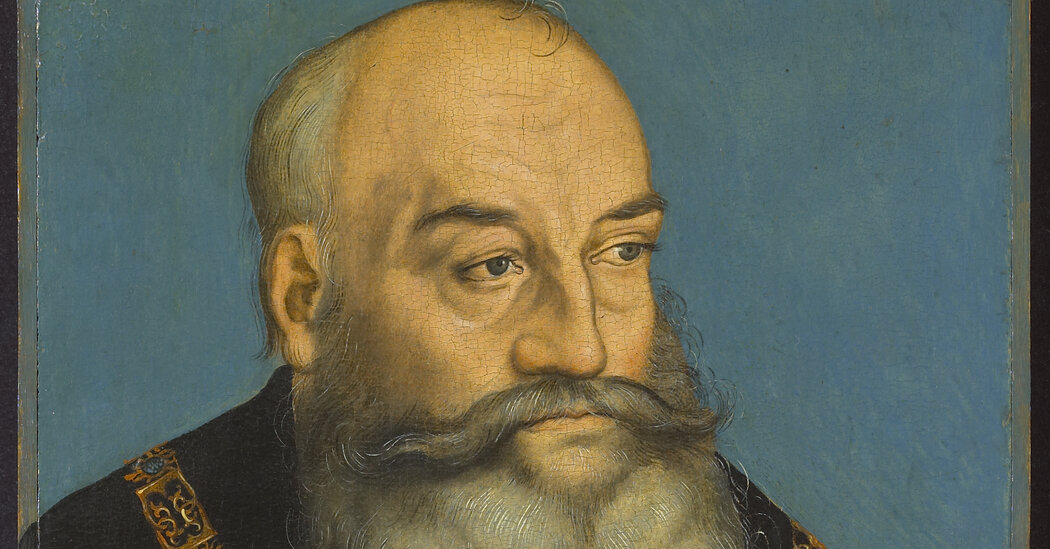A Pennsylvania museum is giving up a prized Sixteenth-century portrait attributed to Lucas Cranach the Elder and his workshop after reaching an settlement with the descendants of a few German Jews who fled the Nazis earlier than World Warfare II.
The Allentown Museum of Art agreed to surrender “Portrait of George Bradatia, Duke of Saxony” following a declare by the household of Henry and Herta Bromberg, who fled Germany in 1938.
As a part of the settlement, the work, an oil on panel relationship to round 1534, might be offered at Christie’s New York Outdated Grasp sale in January. The proceeds are to be break up between the museum and Bromberg’s heirs, however the events haven’t disclosed particulars of the association.
“This murals entered the market and in the end discovered its option to the museum solely as a result of Henry Bromberg needed to flee persecution from Nazi Germany,” Max Weintraub, the museum’s president and CEO, stated in an announcement. “This ethical crucial compelled us to behave.”
Mr. Bromberg, a Justice of the Peace’s court docket choose in Hamburg, inherited the portrait and different works from his father’s assortment. However he and his spouse offered off the paintings after they left Europe, touring first to Switzerland, then France, earlier than crusing for america in 1939. They finally settled in Pennsylvania, not removed from Allentown.
“Whereas being hunted and fleeing Nazi Germany, Henry and Herta Bromberg needed to half with their paintings, promoting it by numerous artwork sellers, together with Cranach,” stated Imke Gillen, a lawyer for Bromberg’s heirs.
Cranach and different works have been offered to the F. Kleinberger Gallery in Paris, in response to the museum, which acquired the portray from a New York gallery in 1961.
The settlement, settled amicably by all accounts, concerned one of the crucial troublesome points that come up in restitution claims, because the events grappled with the query of what degree of duress the Brombergs have been underneath on the time of the sale.
Each events agreed that the portray was offered as a part of the couple’s determined effort to lift the cash wanted to flee Nazi persecution. However the events differed on whether or not the portray was offered earlier than the couple left the tough circumstances of Jewish life in Nazi Germany, as Bromberg’s descendants consider, or after, which a museum lawyer urged was a extra possible situation.
The shortage of certainty about the place the sale occurred paved the way in which for a compromise somewhat than full restitution, in response to museum lawyer Nicholas M. O’Donnell.
“It is a case the place the museum was actually motivated by the code of ethics of American museums on these points and the moral compulsion to compromise each time potential,” Mr O’Donnell stated. He stated the museum first acquired the declare from the household in 2022, and officers stated they believed it was the primary time the museum had returned Nazi looted artwork.
The Bromberg descendants embrace their grandchildren and shut family members who dwell in america and Europe.
In recent times, two different works that when belonged to the Bromberg assortment have been returned to them by the French state: a Sixteenth-century portrait attributed to the college of Joos van Cleve and triptych attributed to the workshop of the Sixteenth-century Antwerp painter Joachim Patinir.
Ms. Gillen, a lawyer for the descendants, stated the household had additionally recognized two different artworks that have been in non-public collections and reached settlements with their house owners. Household heirs are nonetheless trying to find round 80 artworks they consider have been misplaced to their family members attributable to Nazi persecution.
In an announcement, relations stated: “We’re delighted that one other portray from our grandparents’ artwork assortment has been recognized and are happy that the Allentown Museum of Artwork has fastidiously and responsibly verified the provenance and circumstances of the portrait of George Bradatia, Duke of Saxony , by which Henry and Herta Bromberg needed to half along with her through the Nazi interval.
They stated the Brombergs first settled in New Jersey earlier than transferring to Pennsylvania a number of years later to be close to considered one of their sons. “This makes the honest and simply resolution for the portray on the Allentown Museum of Artwork particularly particular,” they stated.
Christie’s stated it couldn’t but give a precise worth for the work earlier than the public sale because it was nonetheless figuring out the portray’s correct attribution. Mark Porter, chairman of Christie’s Americas, stated in an announcement that his analysis “results in the tentative conclusion that this was painted by Cranach utilizing his workshop.”
Cranach additionally painted the Allentown portray’s topic’s cousin, John Frederick I, Elector of Saxony. This portrait offered in 2018 for $7.7 million, the best quantity ever paid at public sale for a Cranach portrait of a single particular person. A diptych portrait he painted offered for extra. Including an artist’s workshop to the portray’s attribution would often decrease the value. The very best public sale worth for a piece cataloged as Lucas Cranach and Workshop was set in 2009 at about $1.1 million.
“It’s thrilling any time a piece by a uncommon and necessary Northern Renaissance grasp comparable to Lucas Cranach the Elder turns into obtainable, particularly on account of honest restitution,” Mr Porter stated.

